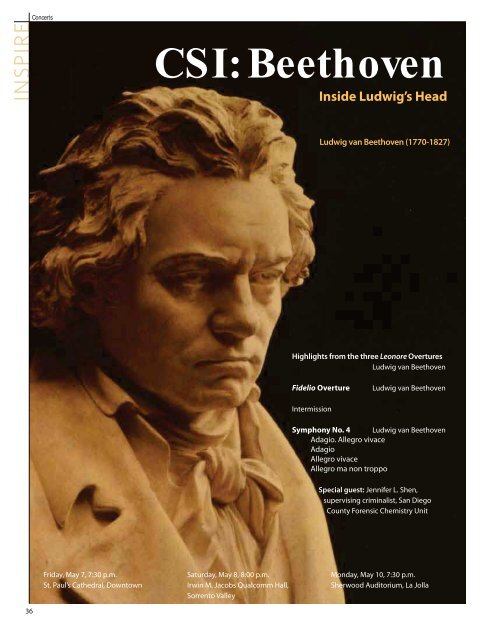The Stars of our Orchestra - Orchestra Nova San Diego
The Stars of our Orchestra - Orchestra Nova San Diego
The Stars of our Orchestra - Orchestra Nova San Diego
Create successful ePaper yourself
Turn your PDF publications into a flip-book with our unique Google optimized e-Paper software.
36<br />
Concerts<br />
Friday, May 7, 7:30 p.m.<br />
St. Paul’s Cathedral, Downtown<br />
CSI: Beethoven<br />
Saturday, May 8, 8:00 p.m.<br />
Irwin M. Jacobs Qualcomm Hall,<br />
Sorrento Valley<br />
Inside Ludwig’s Head<br />
Highlights from the three Leonore Overtures<br />
Ludwig van Beethoven<br />
Fidelio Overture Ludwig van Beethoven<br />
Intermission<br />
Ludwig van Beethoven (1770-1827)<br />
Symphony No. 4 Ludwig van Beethoven<br />
Adagio. Allegro vivace<br />
Adagio<br />
Allegro vivace<br />
Allegro ma non troppo<br />
Special guest: Jennifer L. Shen,<br />
supervising criminalist, <strong>San</strong> <strong>Diego</strong><br />
County Forensic Chemistry Unit<br />
Monday, May 10, 7:30 p.m.<br />
Sherwood Auditorium, La Jolla<br />
On Monday, March 26, 1827,<br />
Ludwig van Beethoven died at<br />
the age <strong>of</strong> 56 in Vienna.<br />
Melody to malady<br />
Beethoven’s health was quite normal<br />
as a boy. However, in his early 20s, he<br />
developed chronic illnesses that plagued<br />
him throughout his adult life. His primary<br />
complaint was abdominal pain which was<br />
referred to as “colic.”<br />
His personality also transformed during<br />
these years <strong>of</strong> illness. <strong>The</strong> friendly and<br />
charming young man gradually became<br />
irritable, hot-tempered and socially isolated.<br />
At the age <strong>of</strong> 31, Beethoven reported that<br />
he was losing his hearing. He was nearly<br />
completely deaf by the age <strong>of</strong> 42.<br />
He experienced a prolonged and painful<br />
death after developing pneumonia.<br />
His death was witnessed by his sisterin-law<br />
and his close friend Anselm<br />
Hüttenbrenner, who provided a vivid<br />
description <strong>of</strong> the event.<br />
“When I am dead, request on my behalf<br />
Pr<strong>of</strong>essor Schmidt, if he is still living, to<br />
describe my disease, and attach this<br />
written document to his record, so that<br />
after my death at any rate the world and<br />
I may be reconciled…” Beethoven to<br />
brothers Karl and Johann in 1802.<br />
It was just a snip <strong>of</strong> hair — but<br />
what a story!<br />
<strong>The</strong> day after Beethoven’s death, a<br />
15-year-old Jewish musician named<br />
Ferdinand Hiller snipped<br />
a large lock <strong>of</strong> the<br />
composer’s hair as<br />
a keepsake. For a<br />
century, the lock <strong>of</strong><br />
hair was a treasured<br />
family keepsake.<br />
During the Holocaust in Nazi<br />
Germany, the lock <strong>of</strong> hair was given to<br />
Kay Fremming, a Danish doctor who<br />
was secretly involved in efforts to save<br />
hundreds <strong>of</strong> hunted and frightened Jews.<br />
After Fremming’s death, his daughter<br />
consigned the lock <strong>of</strong> hair for auction<br />
at Sotheby’s in London. <strong>The</strong> successful<br />
bidders were f<strong>our</strong> Americans, including Ira<br />
Brilliant, founder <strong>of</strong> the Beethoven Center<br />
in <strong>San</strong> Jose, California. <strong>The</strong> new owners<br />
selected the Health Research Institute to<br />
derive scientific information from the hair.<br />
<strong>The</strong> mystery is solved — or is it?<br />
Non-destructive chemical testing <strong>of</strong> the<br />
hair was performed by two separate<br />
laboratories with the<br />
greatest technological<br />
capability for chemical<br />
analysis <strong>of</strong> tiny objects.<br />
Results <strong>of</strong> the scientific<br />
analysis <strong>of</strong> the hair<br />
samples:<br />
<br />
<strong>of</strong> lead, indicating lead<br />
poisoning<br />
<br />
evidence that Beethoven did not receive<br />
medical treatment for syphilis, usually<br />
treated in the 1820s with mercury<br />
compounds; supporting the consensus<br />
<strong>of</strong> Beethoven scholars who believe that<br />
Beethoven never had syphilis<br />
<br />
that Beethoven avoided opiate painkillers<br />
during his long and painful death;<br />
history records that he continued<br />
working on his music until the day he<br />
died, implying that he decided to keep<br />
his mind clear for his music<br />
So, lead poisoning was responsible<br />
for Beethoven’s miserable<br />
illnesses, but how did the<br />
poison get into his body?<br />
No one knows for certain, <strong>of</strong><br />
c<strong>our</strong>se, but water flowed<br />
through lead pipes in<br />
Vienna and most drinking<br />
containers were made<br />
<strong>of</strong> lead during that<br />
time. And Beethoven<br />
did love wine.<br />
However, lead poisoning isn’t usually<br />
associated with deafness — so the<br />
mystery continues.<br />
<strong>The</strong>n there was the skull<br />
Beethoven’s body was exhumed in 1863<br />
for an autopsy, but two bone fragments<br />
from his skull (1.75 inch pieces) didn’t<br />
make it back into the grave. <strong>The</strong>y were<br />
eventually passed down through<br />
generations to Paul Kaufmann in Danville,<br />
California, who has loaned them to the<br />
Beethoven Center.<br />
Those bones were studied<br />
and determined to be<br />
Beethoven’s after the DNA<br />
matched the DNA from his<br />
lock <strong>of</strong> hair.<br />
And the mystery<br />
continues<br />
A small sample <strong>of</strong> the<br />
skull bone has been set aside for future<br />
tests as scientists continue their work<br />
toward identifying a gene, nicknamed “the<br />
Beethoven gene,” that might cause deafness.<br />
During the original autopsy one day after<br />
his death, his inner ears were removed from<br />
his body and have never been recovered.<br />
37


